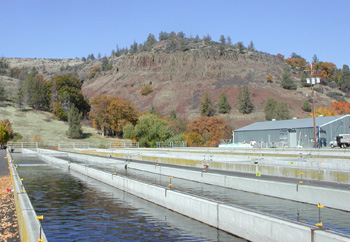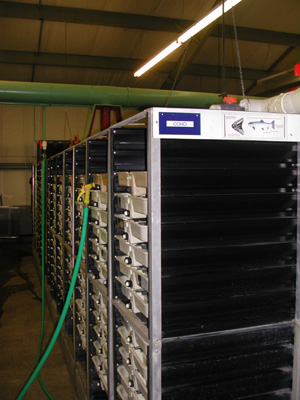Bibliography Background About KRIS
Hatcheries
 Hatcheries have long been thought of as the solution to declining salmon and steelhead populations. Livingston Stone (1872), who founded California's first hatchery spoke of the need to use fish culture to stave off the loss of salmon in the face of unrelenting habitat destruction. Large hatcheries have been part of mitigation strategies for dams in California back to the 1930's, with large facilities built at the base of high dams to serve to offset lost habitat. Small scale hatcheries have also been in operation since the 1960s in northwestern California to help prevent declines of populations in the face of declining habitat and to supplement ocean sport and commercial fisheries.
Hatcheries have long been thought of as the solution to declining salmon and steelhead populations. Livingston Stone (1872), who founded California's first hatchery spoke of the need to use fish culture to stave off the loss of salmon in the face of unrelenting habitat destruction. Large hatcheries have been part of mitigation strategies for dams in California back to the 1930's, with large facilities built at the base of high dams to serve to offset lost habitat. Small scale hatcheries have also been in operation since the 1960s in northwestern California to help prevent declines of populations in the face of declining habitat and to supplement ocean sport and commercial fisheries.
If there are fundamental ecological problems with stream or river systems, planting more fish may not result in a sustained increase in the fish population. Indeed, California's hatchery program has failed in some cases to prevent the loss of some runs of salmon and steelhead on rivers where they operate (Kier Associates, 1991 and 1999). Hatchery operations may also have negative effects on wild populations.
Stock Transfer: The greatest potential problem with hatchery operation with regard to impacts on wild fish occurs when non-native strains of salmon or steelhead are introduced (Solazzi et al., 1983). Non-native coho planted in Oregon coastal streams not only survived poorly, but also lowered survival rates of the native juveniles. The overall result was a decrease in coho returns even immediately after supplementation (Solazzi et al., 1983). Riggs (1990) noted that continually planting non-native stocks in a watershed can cause loss of the local population by decreased fitness through genetic "swamping". Inter-basin stock transfer has been a common practice in northern California (Higgins et al., 1992).
 Disease Introduction: Hatcheries rear eggs and fish at very high densities which makes for higher likelihood of disease outbreaks than in the wild. Importing eggs or fish to a hatchery from other river basins increases the risk of introducing diseases to which native fish have little resistance (PNFHPC, 1989). See Fish Disease section..
Disease Introduction: Hatcheries rear eggs and fish at very high densities which makes for higher likelihood of disease outbreaks than in the wild. Importing eggs or fish to a hatchery from other river basins increases the risk of introducing diseases to which native fish have little resistance (PNFHPC, 1989). See Fish Disease section..
Hatchery/Wild Competition: Steward and Bjornn (1990) found that competition between hatchery juveniles and wild juveniles caused a decline in wild fish in numerous case studies throughout the Pacific Northwest. A Pacific Fisheries Management Council report (1993) found that high hatchery releases in the Klamath and Trinity Rivers is likely to have contributed to record low escapements in the Klamath Basin from 1990-1992.
Mixed Stock Harvest: Hatchery fish can be harvested at the 90% level and maintain their population because of high survival from egg to smolt in the hatchery. Wild fish can only withstand about a 65% harvest rate (Fraidenberg and Lincoln, 1985). Fisheries off the California coast catch hatchery and wild salmon indiscriminately. In the 1970s, as habitat declined for wild fish, hatchery production increased. The result was that overall catch rates were maintained through the mid-1980s with hatchery fish masking the decline of wild populations. Since the early 1990s commercial and sport harvests have been restricted to protect wild stocks. Retaining coho salmon has been prohibited in ocean fisheries since 1994. To read more about large scale hatcheries including effects on wild populations and potential side effects of operation see Pacific Watershed Associates (1994).
Small Scale Hatcheries: The California Department of Fish and Game (CDFG) has allowed some small scale fish culture facilities to be operated cooperatively by restoration groups and other agencies, such as the U.S. Forest Service. In some cases, small scale hatcheries, when operated in conjunction with habitat protection and restoration efforts, have helped small wild salmon populations to rebound. Horse Linto Creek, a tributary of the Trinity River, is an example (Hillemeier and Farro, 1995). The operation of small hatcheries may also pose problems for wild populations, however (Pacific Watershed Associates, 1994). Since they handle small populations in some cases, brood handling practices must recognize the potential for loss of genetic diversity.
Hard et al. (1992) gave recommendations for small scale hatcheries to avoid loss of genetic diversity and other adverse impacts to wild fish:
- Mark all releases with fin clips
- Conduct genetic tests to detect possible shifts in population related to culture
- Spawn all segments of the adult population (run timing, age at maturity, etc.)
- Always mate one male and one female or use factorial designs but never pool eggs and milt.
- Do not use hatchery raised adults as broodstock.
- Avoid unintended selection by varying release strategies and monitoring success rates and changes in life history.
- Modify programs that have negative effects on wild fish or discontinue hatchery operations.
References
Fraidenberg, M.E. and R.H. Lincoln, 1985, Wild chinook salmon management: an international conservation challenge. North American Journal of Fisheries Management, Vol. 5, 3A, 311-329.
Hankin, D.K., 1985, Analysis of recovery data from fall chinook salmon released from Iron Gate Hatchery and Trinity River Hatchery, and implications for management of wild and hatchery chinook salmon stocks in the Klamath River system. Contract with USDI, Bureau of Indian Affairs, Northern California, Hoopa, CA, 117 p.
Hard, J.J., R.P. Jones, Jr., M.R. Delarm, and R.S. Waples, 1992, Pacific salmon and artificial propagation under the Endangered Species Act. US Department of Commerce, National Marine Fisheries Service, Technical Memorandum NMFS-NWFSC-2, Seattle, WA.
Higgins, P., S. Dobush and D. Fuller, 1992, Factors in northern California threatening stocks with extinction. Prepared for the Humboldt Chapter American Fisheries Society, Arcata, CA, 26 p.
Hillemeier, D. and M. Farro. 1995. Final Report: Review and Evaluation of Horse Linto Creek Rearing Facility, 1985-1994. Arcata, CA.
Kier (William M.) Associates. 1991.. Long Range Plan for the Klamath River Basin Conservation Area Fishery Restoration Program. Klamath River Basin Fisheries Task Force. Yreka, CA.
Kier Associates. 1999. Mid-term Evaluation off the Klamath River Basin Fisheries Restoration Program. Prepared for The Klamath River Basin Fisheries Task Force. Sausalito, CA. 303 pp.
Pacific Fishery Management Council (PFMC), 1993, Draft report on an assessment of the status of the Klamath River fall chinook stock as required under the definition of overfishing. PFMC, Portland, OR.
Pacific Northwest Fish Health Protection Committee (PNFHPC), 1989, Model Comprehensive Fish Health Protection Program. PNFHPC, 1002 N.E. Holladay Street, Portland, Oregon.
Pacific Watershed Associates. 1994. Action plan for the restoration of the South Fork Trinity River watershed and its fisheries. Prepared for U.S. Bureau of Reclamation and the Trinity River Task Force, Contract No. 2-CS-20-01100. February 1994.
Riggs, L., 1990, Principles for genetic conservation and production quality. Northwest Power Planning Council, Contract No. C90005, Portland, OR.
Solazzi, M.F., S.L. Johnson, T.E. Nickelsen, 1983, The effectiveness of stocking hatchery coho presmolts to increase rearing densities of juvenile coho in Oregon coastal streams. Oregon Dept. of Fish and Wildlife, Portland, OR, 14 p.
Steward, C.R. and T.C. Bjornn, 1990, Supplementation of salmon and steelhead stocks with hatchery fish: a synthesis of published literature. Idaho Cooperative Fisheries and Wildlife Research Unit, Univ. of Idaho, Moscow, ID, Tech. Report 901.
